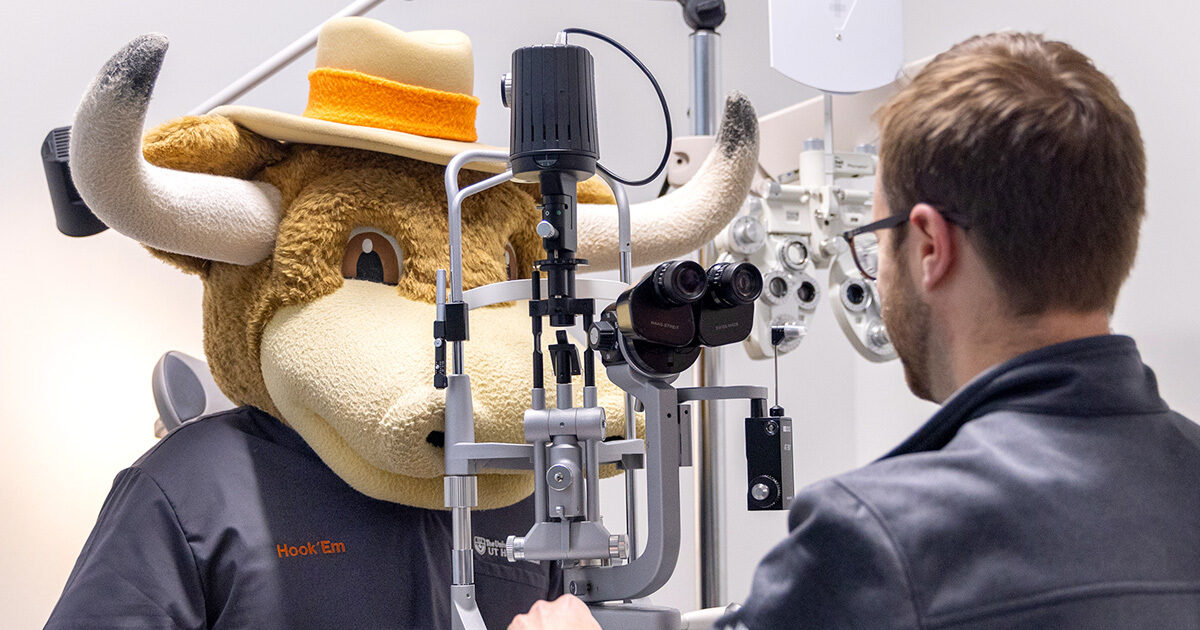Bringing Cataracts Into Focus
UT Health Austin ophthalmologist offers clarity on the leading cause of blindness
Reviewed by: Eileen Bowden, MD
Written by: Lauren Schneider

Ophthalmologists often say, “Cataracts are a consequence of having a lot of birthdays.” The leading cause of blindness worldwide, cataracts are the result of a breakdown in proteins in the eye’s lens that affects everyone to some extent over time.
“Eventually, everyone who lives to be old enough develops cataracts,” says Eileen Bowden, MD, a board-certified ophthalmologist in UT Health Austin’s Mitchel and Shannon Wong Eye Institute. Dr. Bowden specializes in disorders that effect the anterior segment, the front portion of the eye comprised of the cornea, iris, and lens.
Learn more about the second leading cause of blindness.
<br>Common Cataract Culprits
The lens is a clear structure that focuses the light passing into the eye. Over time, proteins within the lens break down and clump together, forming cataracts that cloud vision. “Over a person’s lifetime, the naturally clear lens they are born with begins to grow cloudy for a number of reasons, causing the symptoms of cataracts,” explains Dr. Bowden.
Common symptoms of cataracts include:
- Appearance of “halos” around bright lights
- Clouded, blurred, or dim vision
- Difficulty seeing at night
- Double vision
- Fading or yellowing of colors
- Frequent changes in eyeglasses or contact lens prescriptions
- Headache due to changes in vision
- Need for brighter than normal light to read or see objects
- Sensitivity to light and glare
Age-Related Cataracts
According to the National Institutes of Health (NIH), most people over the age of 80 either have age-related cataracts or have already had surgery to correct cataracts. Age-related cataracts form over the course of decades and may not present symptoms at first.
“Usually around the time a person turns 40 or 50, an ophthalmologist may notice during an eye exam that their lens is no longer crystal clear,” says Dr. Bowden. “In such cases, we notify the patient and tell them to monitor their vision. We won’t really address the cataract until they begin to notice changes in their vision and experience problems with their activities of daily living, such as reading, driving, and working.”
Other Causes of Cataracts
Some people develop cataracts sooner in life due to disruptions to the environment inside the lens that accelerate protein degradation.
The following risk factors are commonly associated with earlier cataract onset:
- Diabetes: High levels of glucose and glucose byproducts in the bloodstream can adversely affect lens proteins.
- Family history of cataracts: Genetic problems with lens proteins can cause them to break down sooner.
- Previous eye surgery: If the lens is disturbed during eye surgery, proteins within the lens may degrade more rapidly.
- Radiation: Exposure to radiation, either from the sun’s ultraviolet rays or from radiation treatment, is associated with cataract onset.
- Smoking: Smoking causes an imbalance between free radicals and antioxidants in the body known as oxidative stress, which damages tissues throughout the body, including the lens.
- Use of steroid medication: Corticosteroid treatment is associated with a form of cataract known as a posterior subcapsular cataract that forms in the back of the lens.
“The best way to prevent the formation of cataracts for as long as you can is to stay healthy, wear sunglasses when outdoors, eat a balanced diet, and manage other conditions such as diabetes,” advises Dr. Bowden. “If someone has a family history of early cataract onset—for instance, if their parents developed cataracts when they were 40 years old—that person should consider seeing an eye doctor every one to two years once they turn 40 themselves.”
Explore the many benefits of an annual eye exam.
<br>Less preventable forms of cataracts include pediatric cataracts, a rare form of cataracts present at birth, and traumatic cataracts, a form of cataracts caused by a traumatic injury to the eye or head. “Traumatic cataracts can develop quickly, sometimes in months, days, or even hours after the injury,” warns Dr. Bowden.
One Surgery, Many Options
Regardless of cause, cataracts are usually treated through surgery during which the cloudy lens is replaced with a clear artificial lens. “Cataract surgery is the most common surgical procedure performed in the United States, but the treatment can look different for each patient,” explains Dr. Bowden. “For example, while rapid-onset traumatic cataracts may require urgent intervention, many other patients can choose whether they wish to undergo the surgery at all.”
“Not everybody who has a cataract needs surgery, and untreated cataracts will not significantly harm your eyes,” continues Dr. Bowden. “I would recommend surgery to a patient if their visual impairment from cataracts limits their ability to perform their activities of daily living or do the other things that they enjoy.”
In addition to choosing whether to correct cataracts through surgery, patients can choose when they undergo the procedure. “Some people are very bothered by their limited vision early on and want their surgery performed sooner. Others may not want to take risks associated with surgery and choose to live with their cataract symptoms for longer,” notes Dr. Bowden.
“The technology involved in cataract surgery has come a really long way in the past couple decades, making the procedure safer and more straightforward than ever before,” adds Dr. Bowden. Other recent technological advances in the field of cataract surgery include artificial lenses that can correct long-sightedness or nearsightedness, eliminating the need for eyeglasses.
“These days, patients undergoing cataract surgery can customize their treatment to their own preferences,” says Dr. Bowden. “At the Mitchel and Shannon Wong Eye Institute, our ophthalmologists approach each cataract surgery differently and offer treatment plans based on our patients’ individual goals.”
For more information about the Mitchel and Shannon Wong Eye Institute or to schedule an appointment, call 1-833-UT-CARES (1-833-882-2737) or visit here.